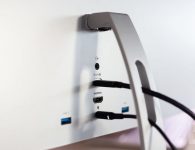
It’s hard to describe Vantaback, the world’s darkest black pigment, without seeing it for yourself.
First developed for use in light-sensitive aerospace components (and infamously licensed for artistic use solely by sculptor Anish Kapoor), the pigment uses tiny carbon nanotubes to absorb up to 99.965% of light striking its surface. At Google’s top secret materials lab, I recently gazed upon a sample of Vantablack in real life for the first time. It almost broke my brain. It has no reflection, no contours. It’s like part of the world has been Photoshopped away. Stare at it long enough, and it feels like your soul is being sucked out of your eyeballs.
I couldn’t imagine any every-day object being painted in Vantablack, let alone one that can move at 90 miles per hour. But at the Frankfurt Motor Show this September, the auto manufacturer will be displaying a one-off BMW X6 painted in Vantablack.
Even in photos, the effect is pronounced. The car itself appears two-dimensional. Only details like the tires, grill, and windows offer visual cues as to the true shape of the car—though in many images, those components simply seem to be floating in space.
It’s a frightening idea, to imagine seeing a Vantablack car on the road. BMW used a more reflective version of the paint, which bounces back a more generous 1% of visible light, for this application. Yet even with a slightly reflective surface, a Vatablack car in your rearview mirror would probably look something like a Looney Tunes tunnel painted on in the middle of the street. Is that an object or a void?
Black cars are notably more dangerous to drive than white cars for reasons of visibility already. A study by Monash University Accident Research Centre in Australia, which studied crash data across the country from 1987 to 2004, found that compared to white cars as a baseline, crash risk was higher for just about every other common color, including red, blue, silver, green, grey, and, yes, black. Black performed the worst by every measure: In daylight, the chance of crash is 12% higher than that of white cars. At dawn and dusk, that jumps to 47%—though your relative risk of getting into an accident at that time is lower at those hours, the authors point out. Monash’s study was consistent with at least one other from the University of Granada, which determined that yellow was a safe alternative to white. The center is a respected resource in vehicle safety, also contributing to the annual Used Car Safety Ratings.
In any case, if black is the least safe color for a car, making that black even blacker seems like an objectively terrible design decision. In fact, BMW confirmed outright that this car will not be going into production. As to whether or not the company considers it safe? “The car hasn’t been made for road test drives and hasn’t seen daylight yet, but we will certainly test it on our proving grounds to see how it reacts/looks outside of a hangar,” a spokesperson said. “Therefore, we can’t answer this question yet.”
So why make this car at all? Is it simply to get the attention of headlines? Or could it be teasing something else about BMW’s future?
In fact, the latter seems to be the case.
“The Vantablack X6 is the first project we had using this material, but we are thinking of other applications than coating a car (which is more a test or a show car purpose),” they say. “For example, the use of Vantablack allows to reduce drastically sun reflections on screens/displays/lenses and could make it’s way in Head-up-Displays or camera lenses used for driving assistant systems, making them more accurate by reducing reflections.”
In other words, the future of Vantablack in cars probably won’t be on the outside of vehicles, but on their insides, where reflection can actually hinder visual perception. I, for one, cannot wait to spill fries and latte foam all over my Vantablack dashboard.
read more at https://www.fastcompany.com by Mark Wilson
Tech







